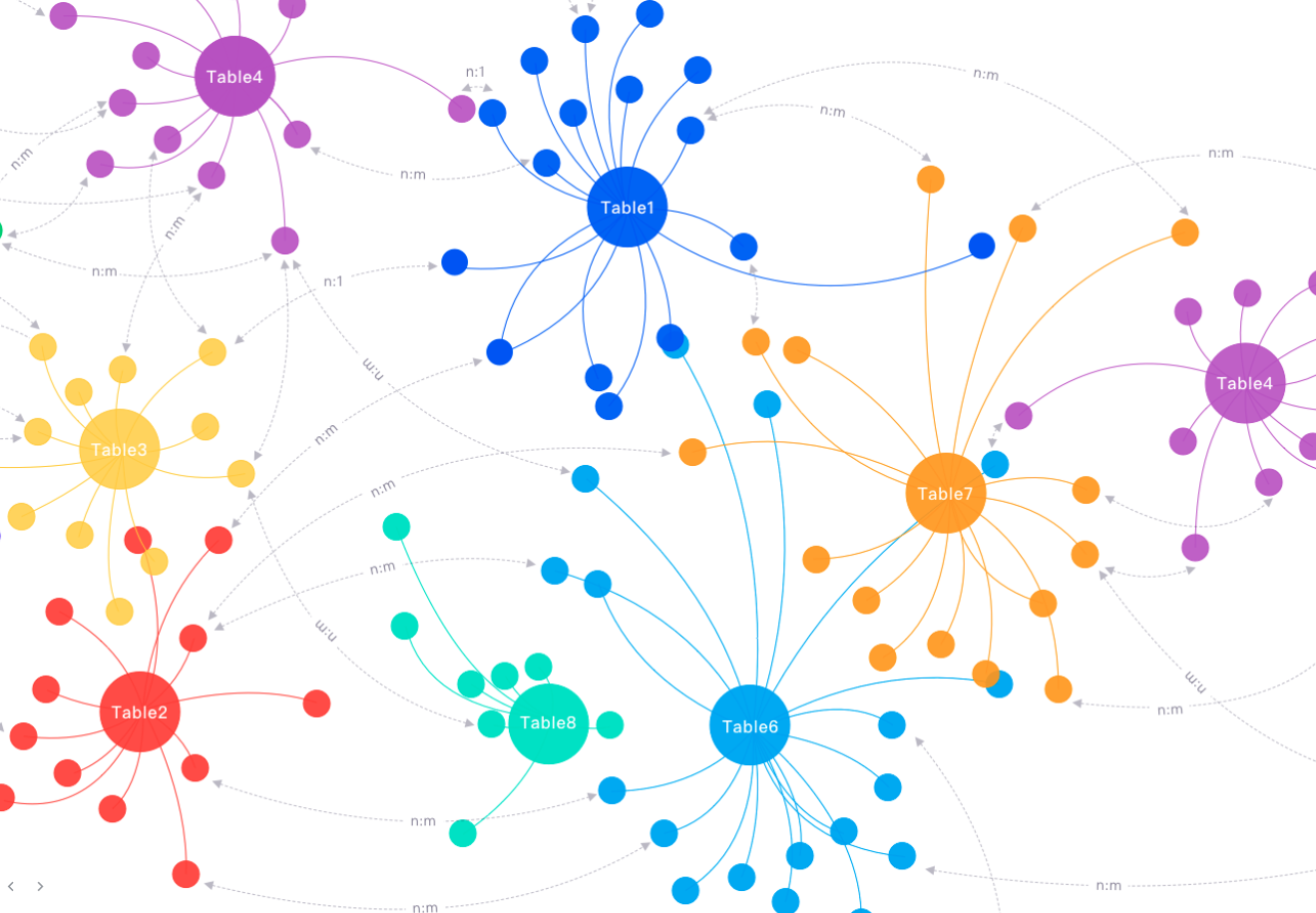啊、需求你如此丰富,促使我进步。
总之又搞起antv了。
先看需求图

没时间记录分析过程,直接上代码:
获取二次贝塞尔曲线控制点
function getPoint(sx, sy, ex, ey) {
// 获取开始,结束点所在直线1公式
const k = (ey - sy) / (ex - sx);
const b = (k * (sy + ey) + (sx + ex)) / (2 * k);
// 以开始点为旋转中心,逆时针旋转30度,获得该直线2公式
const angle = Math.atan2(ey - sy, ex - sx) / (Math.PI / 180) + 30;
const k1 = Math.tan((Math.PI * angle) / 180);
const b1 = sy - k1 * sx;
// 中间控制点即为直线1和2的交点
const c1x = (b - b1) / (k1 + 1 / k);
const c1y = k1 * c1x + b1;
// 以数组形式返回中间控制点坐标
return [c1x, c1y];
}
第一种方式在quadratic上拓展
G6.registerEdge(
'line-arrow',
{
labelPosition: 'center',
labelAutoRotate: true,
getShapeStyle: function getShapeStyle(cfg) {
const { startPoint } = cfg;
const { endPoint } = cfg;
const b = getPoint(startPoint.x, startPoint.y, endPoint.x, endPoint.y);
const style = G6.Util.mix(
{},
G6.Global.defaultEdge.style,
{
stroke: 'rgba(194, 192, 203, 1)',
lineWidth: 1,
lineDash: [2, 2, 2],
path: [
['M', startPoint.x, startPoint.y],
['Q', b[0], b[1], endPoint.x, endPoint.y],
],
startArrow: {
path: 'M 0,0 L -6,-3 L -6,3 Z',
},
endArrow: {
path: 'M 0,0 L -6,-3 L -6,3 Z',
},
},
cfg.style
);
return style;
},
},
'quadratic'
);
第二种方式,直接自己定义边
G6.registerEdge(
'line-arrow',
draw: function draw(cfg, group) {
const { startPoint, endPoint } = cfg;
const b = getPoint(startPoint.x, startPoint.y, endPoint.x, endPoint.y);
const shape = group.addShape('path', {
attrs: {
path: [
['M', startPoint.x, startPoint.y],
['Q', b[0], b[1], endPoint.x, endPoint.y],
],
stroke: 'rgba(194, 192, 203, 1)',
lineWidth: 1,
lineDash: [2, 2, 2],
startArrow: {
path: 'M 0,0 L -6,-3 L -6,3 Z',
fill: '#333',
stroke: '#666',
},
endArrow: {
path: 'M 0,0 L -6,-3 L -6,3 Z',
fill: '#333',
stroke: '#666',
},
},
});
const a = [(startPoint.x + endPoint.x) / 2, (startPoint.y + endPoint.y) / 2];
group.addShape('text', {
attrs: {
text: cfg.label,
fill: 'rgba(194, 192, 203, 1)',
x: (a[0] + b[0]) / 2,
y: (a[1] + b[1]) / 2,
},
});
return shape;
},
},
);
graphin完整代码:
示例data:
{
nodes: [
{
id: 'node-0',
label: 'node-node-0',
data: { id: 'node-0', label: 'node-0', properties: [] },
shape: 'CircleNode',
size: 78,
style: { nodeSize: 24 },
},
{
id: 'node-1',
label: 'node-node-1',
data: { id: 'node-1', label: 'node-1', properties: [] },
shape: 'CircleNode',
size: 26,
style: { nodeSize: 24 },
},
],
edges: [
{
shape: 'line-arrow',
source: 'node-0',
target: 'node-1',
label: 'edge-0_1',
labelCfg: {
autoRotate: true,
style: {
stroke: 'white',
lineWidth: 5,
fill: 'rgba(194, 192, 203, 1)',
},
},
data: {
shape: 'line-arrow',
source: 'node-0',
target: 'node-1',
label: 'edge-0_1',
properties: [],
},
},
]
}
<Graphin
style={{ width: '100%' }}
ref={graphRef}
data={{ nodes, edges }}
register={{
edgeShape: (G6) => {
G6.registerEdge(
'line-arrow',
{
labelPosition: 'center',
labelAutoRotate: true,
getShapeStyle: function getShapeStyle(cfg) {
const { startPoint } = cfg;
const { endPoint } = cfg;
const b = getPoint(startPoint.x, startPoint.y, endPoint.x, endPoint.y);
const style = G6.Util.mix(
{},
G6.Global.defaultEdge.style,
{
stroke: 'rgba(194, 192, 203, 1)',
lineWidth: 1,
lineDash: [2, 2, 2],
path: [
['M', startPoint.x, startPoint.y],
['Q', b[0], b[1], endPoint.x, endPoint.y],
],
startArrow: {
fill: 'rgba(194, 192, 203, 1)',
path: 'M 0,0 L -6,-3 L -6,3 Z',
lineDash: [0, 0, 0],
},
endArrow: {
fill: 'rgba(194, 192, 203, 1)',
path: 'M 0,0 L -6,-3 L -6,3 Z',
lineDash: [0, 0, 0],
},
},
cfg.style
);
return style;
},
},
'quadratic'
);
return [
{
name: 'test',
register: () => {},
},
];
},
}}
layout={{
name: 'force',
options: { animation: true, enableWorker: true, damping: 0.5, repulsion: 160 * 5 },
}}
options={setting}
/>